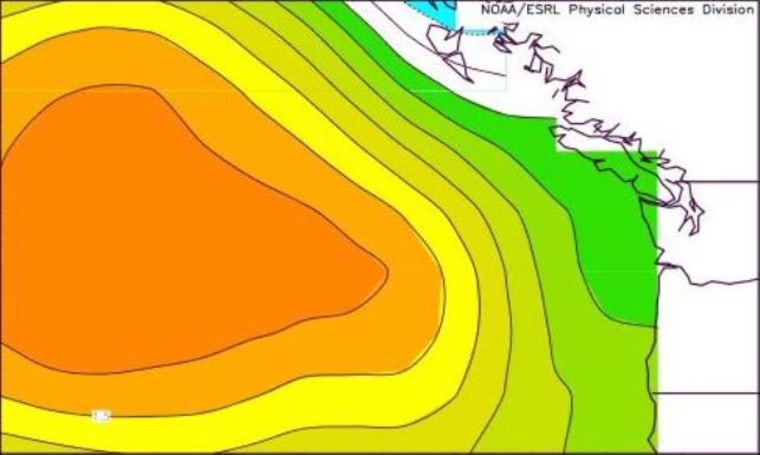What's behind the weirdly warm and dry weather in the West, and the weirdly wet and cold weather in the East? Two studies point to a huge "warm blob" of water that's been lurking off the U.S. West Coast. The long-lived patch, which measures about 1,000 miles (1,600 kilometers) wide, is about 2 to 7 degrees Fahrenheit (1 to 4 degrees Celsius) above normal.
Nick Bond, a climate scientist at the Joint Institute for the Study of the Atmosphere and Ocean at the University of Washington, began watching the blob a year and a half ago. "In the fall of 2013 and early 2014, we started to notice a big, almost circular mass of water that just didn't cool off as much as it usually did, so by spring of 2014 it was warmer than we had ever seen it for that time of year," Bond said in a news release about the studies appearing in Geophysical Research Letters.

During the winter, air passing over the Pacific patch brings more heat and less snow to the coast, which has contributed to the current drought conditions. Bond and his colleagues also say the warmer, less nutrient-rich water is disrupting the marine food web off the U.S. West Coast.
The other study was conducted by Dennis Hartmann, an atmospheric scientist at UW. He links the "polar vortex" chill that gripped the central and eastern U.S. in 2013-2014 to a decadal-scale weather pattern that sent warm, dry air to the West Coast and cold, wet air to the East. Hartmann says the same scenario apparently played out during the winter of 2014-2015.
The weather pattern, known as the North Pacific Mode, is what's causing the Pacific's warm blob as well.
Is global climate change playing a role in the rise of the North Pacific Mode? Neither Bond nor Hartmann is willing to say. "I don't think we know the answer," Hartmann said. "Maybe it will go away quickly and we won't talk about it anymore, but if it persists for a third year, then we'll know something really unusual is going on."
IN-DEPTH
- Four-Year Drought Sparks a 'Water Truck' Boom
- Many in U.S. Face Another Dry Year
- Gallery: Here's What Weird Weather Looks Like
SOCIAL
— Alan Boyle
In addition to Bond, the authors of "Causes and Impacts of the 2014 Warm Anomaly in the NE Pacific" include Meghan Crinin, Howard Freeland and Nathan Mantua. Hartmann is the sole author of "Pacific Sea Surface Temperature and the Winter of 2014."